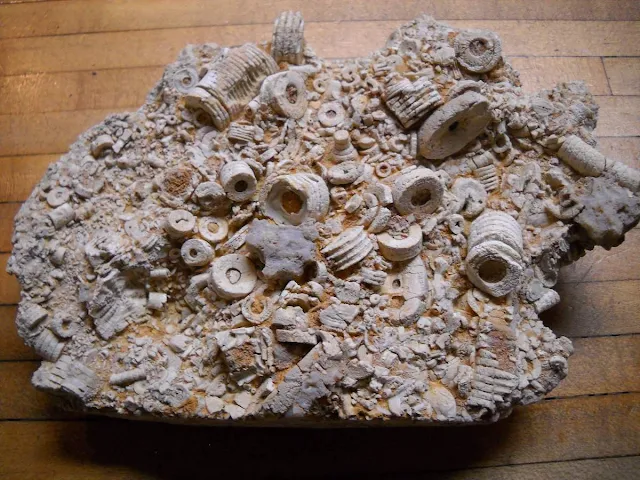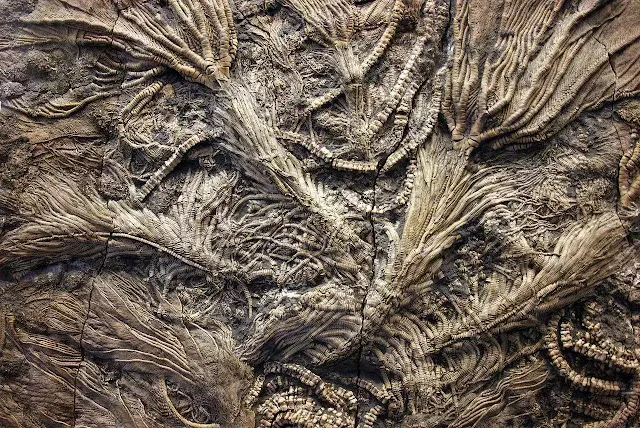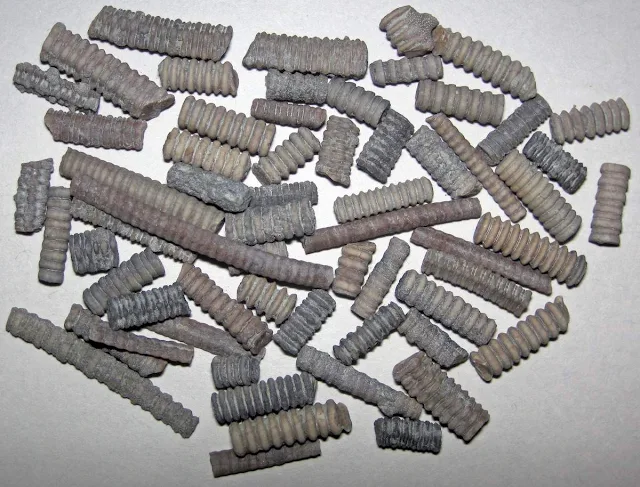Facts About Crinoid Fossils
Crinoids are marine animals that belong to the phylum Echinodermata, which also includes starfish, sea urchins, and sea cucumbers. They are commonly known as sea lilies or feather stars. Crinoids have a long evolutionary history, dating back to the Ordovician period, around 500 million years ago.
Facts about Crinoid fossils
Not Plants
Despite their flower-like appearance, Crinoids are ancient marine animals that first appeared in the Cambrian period, over 500 million years ago. They belong to phylum Echinodermata, closely related to starfish, sand dollars, and sea urchins. Their "arms" are actually feeding appendages, not petals.
Stalked and Non-Stalked Forms
Crinoids come in both stalked (sea lilies) and non-stalked (feather stars) forms. This diversity is reflected in their fossil record, where both types of crinoids are preserved.
Crinoids Played a Crucial Role in Shaping Ancient Reefs
Their numerous arms and feathery appendages helped filter water and trap sediment, contributing to the growth and development of these complex ecosystems.
Ancient Environments Indicators
They provide clues about ancient environments: The presence of crinoid fossils in rocks indicates that the rocks were formed in a marine environment. The abundance of crinoids in certain rocks can also suggest the presence of shallow water conditions.
 |
| Anatomy of crinoid fossils |
Crinoid Are Not All the Same
Crinoid fossils come in a wide variety of shapes and sizes, reflecting the diversity of crinoid species that have existed throughout history. Some fossils are just fragments of the stem, while others are complete individuals with all their arms preserved.
Crinoid Survived Mass Extinctions
Crinoids are one ofthe few animal groups to have survived multiple mass extinction events, showcasing their incredible resilience and adaptability.
Valuable in Biostratigraphy
Crinoid fossils are valuable in biostratigraphy, a branch of paleontology that uses the distribution of fossils in rock layers to correlate and date geological formations. They are particularly useful for dating marine deposits.
Name origin
The name "Crinoidea" comes from the Ancient Greek word κρίνον (krínon), "a lily", with the suffix –oid meaning "like".
 |
| Fossiliferous limestone (encrinital limestones)with crinoid stems from the Ordovician of the Cincinnati area, USA. |
Crinoid Can Be Surprisingly Large
They can be surprisingly large: While many crinoid fossils are small, some species had incredibly long stalks reaching up to 40 meters (130 ft), towering over the seafloor like underwater trees.
Gemstones Sometimes
They've been used as jewelry: Throughout history, Crinoid columnals, the individual disc-shaped segments of the stalk, called "fairy money" or "screwstones," were sometimes used as beads in necklaces and rosaries, offering a unique connection to the past.
 |
Crinoid fossils are often mistaken for ancient screws or bolts |
Limestone Builders
Crinoid fossils were so abundant in some periods that their accumulated remains formed thick limestone beds, used as building materials throughout history. These "encrinital limestones" tell stories of ancient marine ecosystems.
Global Distribution
Fossilized crinoids have been found on every continent, providing evidence of their widespread distribution and importance in past marine ecosystems.
 |
| Fossil crinoids |
Crinoid Fossils Have Inspired Art and Literature
The unusual appearance of crinoids has captured the imagination of people for centuries. They have been used as inspiration for jewelry, art, and even science fiction creatures like the Xenomorphs in the Alien movies.
 |
| Fossil crinoid stems from the Ordovician of Kentucky. |
Crinoid fossils are a valuable resource for paleontologists, geologists, and anyone interested in learning more about the history of life on Earth. They offer a glimpse into a world that existed long before dinosaurs, and they continue to teach us new things about the evolution of marine ecosystems.
Read also: Remarkable 'Alien-Looking' Fossil Found in Australia




%20(1).webp)



